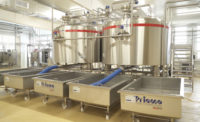Pasta filata cheeses, of which Mozzarella is the most widely known type, are Italian dairy specialties known worldwide. In recent years, their increase in consumption has outstripped other cheeses mainly owing to the increasing consumption of pizza. In this article, GEA looks at the techniques for making this unique ’ricetta’ of cheese that is enjoyed by so many people the world over.
One of the reasons for the growth in the consumption of pasta filata cheese is the increasing trend for consumers to care about what they eat: more customers now want products with a fresh, light style with a subtle flavor. Mozzarella, for example, fits this profile perfectly. It is delicious eaten fresh and is essential for many Italian dishes.
It is also a ‘fast turn round’ product for producers providing an immediate return on the investment in raw materials and production time as mozzarella is ready for consumption immediately without the need for a ripening period. The slogan ‘yesterday milk, today mozzarella, tomorrow on the table’ clearly illustrates how quickly the product can be turned into fast cash flow.
That said, there are two main different types of pasta filata cheese available on the market. Mozzarela has a high moisture content, is made in different shapes and sold in handy-sized packages. It is dipped in a preserving liquid giving it a shelf life of around 30 days.
Industrial products, so called pizza cheese, are made of mostly dry pasta, have a lower moisture content, are packed for commercial use and have a much longer shelf life of up to 4 months. This product is essential for another Italian ‘ricetta: the pizza.
Provolone, Scamorza, Caciocavallo cheeses are made by dry pasta, have a lower moisture content and are matured for weeks; Scamorza can also be smoked. This process intensifies the taste of this typical Italian product.
Mozzarella can be made with either buffalo or cow’s milk or by a combination of them. The table below shows the chemical composition of the relative products:
Production technology
The pasta filata cheese production process makes a clean, sour curd which, with the addition of heat, acquires the characteristic ‘filanti’ features: it can be stretched and molded for a range of applications. The main process steps are as follows:
- Milk is heated to 35°C/38°C in a cheese-making vat. Rennet for coagulation is added. Depending on the specific recipe different starters or acids – citric, lactic or vinegar - are added for acidification process to reach pH 4,9 – 5.8. A combination of starters and acids is also common.
- The curd is cut in pieces.
- A second heating process up to 40°C/42°C is necessary for Provolone and Scamorza cheeses.
- The soured curd is stretched at 60°C/62°C with the traditional warm water or with the unique patented CMT steam injection process (or a combination of them) to create a plastic and extensible consistency with optimized fiber length.
- The pasta filata is molded in different shapes and configurations at a temperature of around 60°C.
- The product is cooled, smoothly, down to 10°C before packing.
- Pasta filata cheeses are required to be salty; this can be done through direct salt addition or through a brine vat.
Each specific ’ricetta’ for pasta filata cheeses can change from product to product and from market to market; the different milk compositions, caused by different feeds or milk production techniques, can also affect the final product. Each producer has his own ’ricetta’.
Features of Biological Acidification (starters)
- Traditional product
- Superior organoleptic quality
- Protection against contamination
- Longer shelf life
Features of Chemical Acidification (acids)
- Reduced acidification time
- Industrial efficiency increase (reduced production time)
- Softer structure
- Light taste
Differences in manufacturing for mozzarella and pizza cheese
The manufacturing technique changes when producing mozzarella compared with pizza-cheese.
Fresh mozzarella (bocconcino, ciliegina and treccia) is a very soft cheese with a high moisture content (58-65%). Production requires the use of pasteurized whole milk to which enzymes and rennet are added. This is coagulated at 35-38°C followed by curd stretching. The cheese is generally lightly salted during stretching phase. Molding, hardening and packing phases follow.
Pizza-cheese has a lower moisture content (48-52%) and is obtained from full fat or skimmed milk. The curd is processed at 35-38°C, followed by a maturation period and a stretching process. Molding, brining and hardening occur before packaging.




